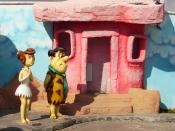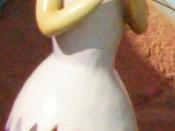What makes a boy and what makes a girl? Exaggerated characteristics or "stereo types" are often used to portray males and females as being different to each other. Examples of this include, dress style and colour, verbal communication, relationships and actions. Such stereotypes are often portrayed and perpetuated in children's television. Good morning Ms Panetta and 9.04. Today I am going to be talking to you about the Flintstones. The Flintstones is targeted at a children's audience from ages between ages 3 and 10, although many older people seem to enjoy the show. By watching and analyzing this program, I have come to the conclusion that the Flintstones perpetuates out-of-date and obsolete stereotypes of how males and females should behave. Unlike other children's programs the Flintstones at first does not seem to be a sexist program. Both male and female have relatively equal parts in the script, and no people or groups are marginalized.
However, there are still very definite constructions of masculinity and femininity that can be observed in the way the characters dress and act, and in the jobs they perform. For example, the program implies that women always do the cooking and cleaning. Not only does Wilma do the cleaning in her house, but also when Fred tries to hire a housekeeper, there are only women to choose from. This program also gives the impression that men are the ones who should do all the corporate work, and manual labour. It is the male characters that run the agencies, banks and the work sites. Like most
husbands, Fred wants his wife, whom is pregnant, to take it easy. He decides to hire some one to do the house keeping. When Fred mentions this to his wife, she immediately goes to the phone to call her mother. Fred...
![[Portrait of Duke Ellington and Sonny Greer, Aquarium, New York, N.Y., ca. Nov. 1946] (LOC)](https://s.writework.com/uploads/6/61491/portrait-duke-ellington-and-sonny-greer-aquarium-new-york-n-thumb.jpg)


Paragraphs
In this essay there are some good ideas that could have been broadened by more descriptive words and examples. The use of paragraphs could have helped to split the essay into sections. A nice read overall.
6 out of 6 people found this comment useful.